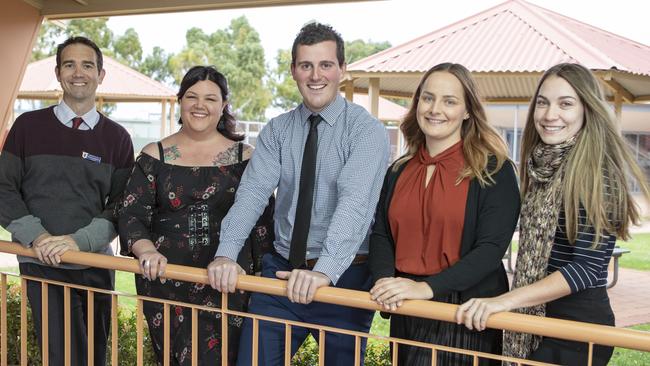Teach for Australia: mining town Kalgoorlie shows program is a gem
Remote Kalgoorlie has turned out to be a great test site for Teach for Australia.

There’s something about Kalgoorlie. Located in outback Western Australia, almost 600km from Perth, “Kal” — as the locals call it — conjures up images of dusty goldfields, rugged miners and “skimpies” (scantily clad female bar staff) but remains largely a mystery to most of the nation’s coast-hugging population.
But despite the challenges isolation brings, the mining mecca with a population of about 30,000 has proven quite the gem for a government-backed program that parachutes accomplished career changers and high-achieving university graduates into teaching jobs in disadvantaged and hard-to-staff secondary schools.
Since Teach for Australia’s John Inverarity selected Kalgoorlie in 2016 to be the first regional location in Western Australia to send trainee teachers, known as associates, it has placed 11. So far all five who have graduated from their fast-tracked teacher training (with master’s degrees) have stayed on in their schools.
It is not a bad feat for a city known for its transient workforce.
Established in 2008 and based on a similar US program, Teach for Australia’s goal is to break the cycle of educational disadvantage that exists in parts of the country. The organisation cites research suggesting that by the age of 15, students from low socio-economic households are almost three years behind in school compared with those from wealthier families, and about 40 per cent of children from the lowest socio-economic backgrounds do not complete Year 12.
Meanwhile, the persistent education gap between indigenous and non-indigenous students, particularly in remote communities, is well documented.
Despite its best intentions, the program has attracted critics, including the Australian Education Union, which once characterised it as an “expensive distraction” and “waste of money that will do nothing to help disadvantaged schools”. But last year an independent evaluation found that principals rated it highly, claiming Teach for Australia associates outperformed other early-career teachers. The report also urged that more needed to be done to retain them in the profession.
On paper, Kalgoorlie, with its high levels of welfare dependence, relatively poor educational outcomes and Aboriginal disadvantage, was a perfect fit.
But Inverarity, who began his teaching career after playing cricket for Australia, was keen to find out whether the community was also a good fit for young and ambitious incoming teachers, many whom were likely to relocate from big cities.
“My wife and I got the train up to Kalgoorlie, which took about seven or eight hours,” he says.
“We wanted to immerse ourselves in the experience and imagine what it would be like if we were in our 20s going off to teach there. We ate dinner at the different pubs, visited the schools, watched in the evenings as the kids would play their sports … and we got the feeling that it would work very well.”
For the teaching associates who have come to Kalgoorlie, the negatives — isolation, homesickness and “distance from the beach”, according to one — are significantly outweighed by the positives.
Vanessa Macri gave up a 15-year career as an archeologist and heritage consultant to teach. Soon after graduating from university in 2001, she headed overseas to work on commercial excavations in Ireland and Britain.
She loved her work but, having returned to Australia, found the industry was changing.
Teaching geography and English at Eastern Goldfields College, she has found she has a natural affinity for teaching: “I genuinely love it.” She also works with students, many of whom have faced significant personal challenges, in a senior school engagement program, as well as with indigenous students in the school’s Follow the Dream tutoring program. “To be honest, I don’t think I could have ended up in a better place to start my teaching career,” Macri says. “The youth of Kalgoorlie face many issues that kids in bigger, more connected places don’t, but they have so much resilience. I think this is why I was drawn here.”
The teachers who have moved to Kalgoorlie have built strong relationships with each other.
John Paul College’s Bridget Staude, a politics and international relations graduate before turning to teaching, describes her Teach for Australian network as her closest friends.
Science teacher Cameron Halvorson relies heavily on the support of his colleagues. He also has been playing football with the Mines Rovers Football Club for three years and coaching an under-12s side for the past two.
“The town has been great and I’ve always found that the more you put into it the more it gives back,” he says.
Staude, however, says it can be hard to connect with other young people in town because of the transient nature of mining work: “People are often coming and going.” So, earlier this year she founded the Kalgoorlie Young Professionals group, which holds networking events for young people, to help address this issue.
“I have also been involved in volunteering with the Red Cross Soup Patrol over the last couple of years, which has given me a much clearer insight into the disadvantage in this community, which can be quite hidden,” she says.
John Paul College acting principal Troy Francesconi says Teach for Australia associates typically arrive with a strong work ethic and desire to make a difference.
“They see the job as a vocation,” he says. “The town is fantastic for young people, with a younger population and good social links through sports and other clubs. The younger staff, provided they are open to change, generally develop really strong friendships from their time in Kalgoorlie, particularly through school.”
